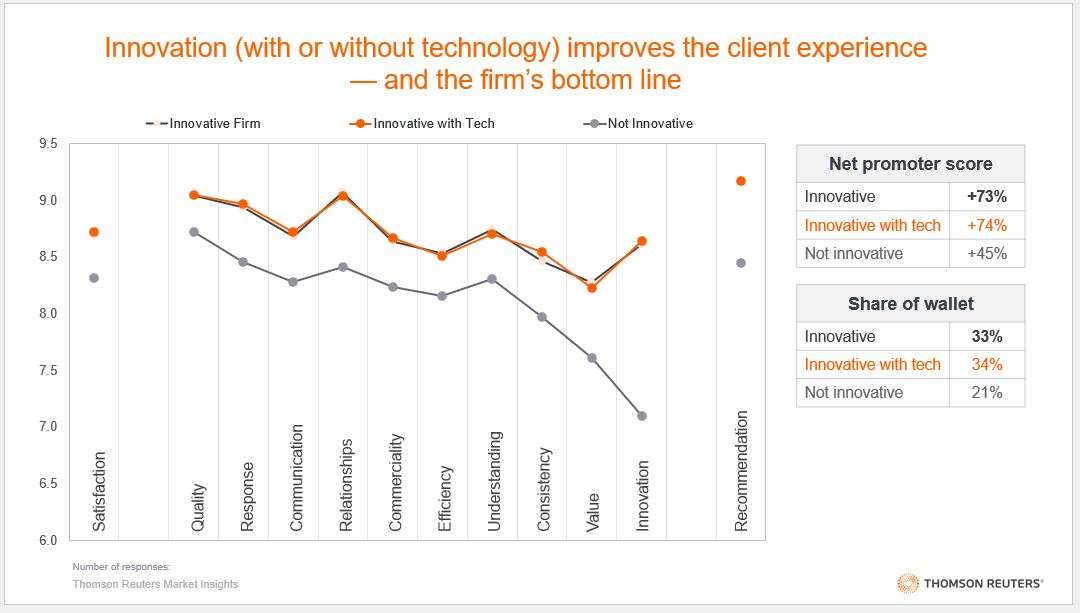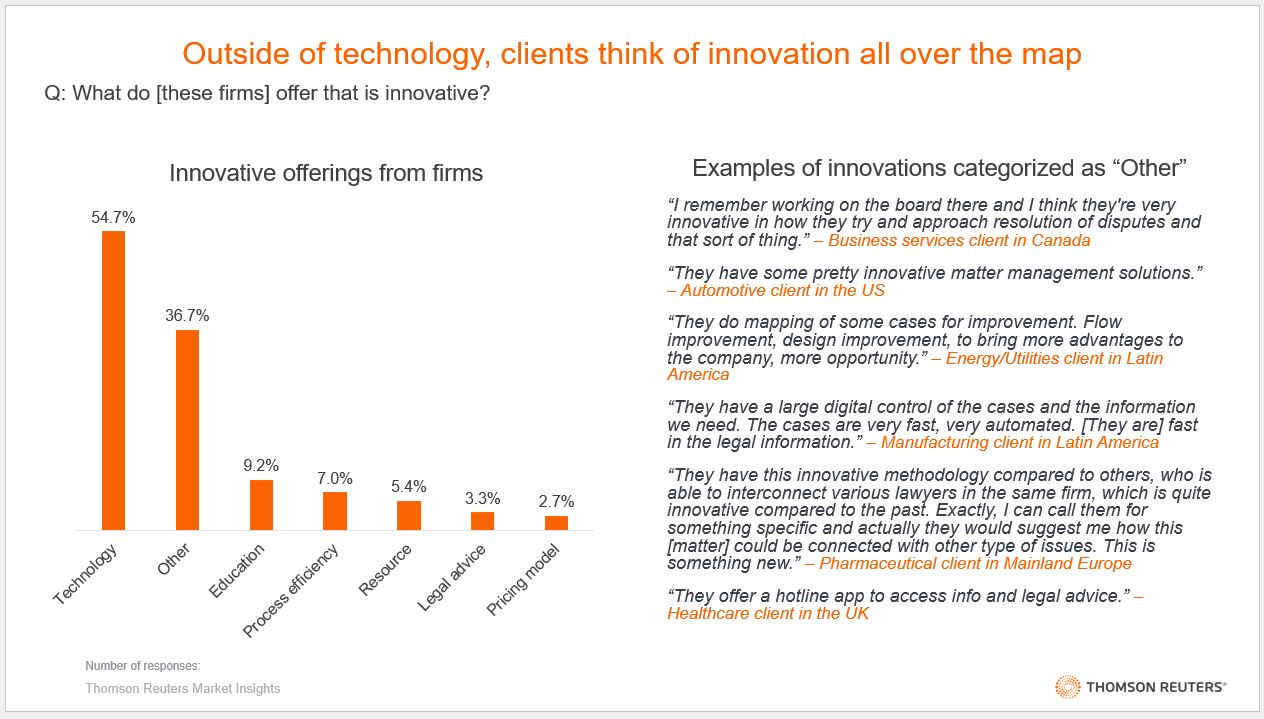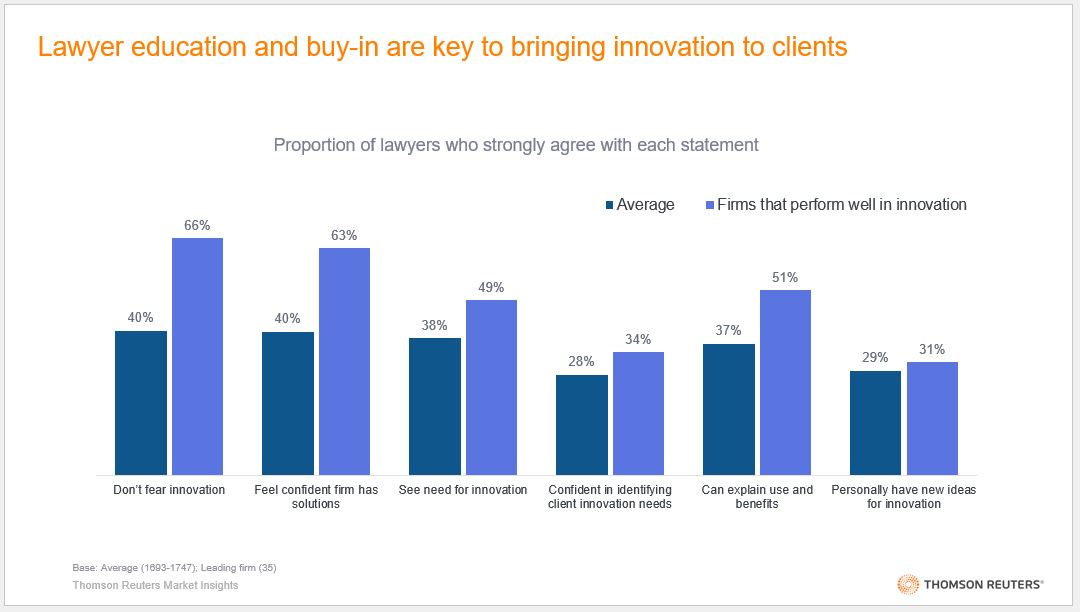For law firms and other legal organizations, what counts as innovation? Is it always related to technology? Is it worth pursuing?
Innovation has been a topic of much discussion in the legal market recently, and many of the conversations around it show that there’s considerable confusion around what innovation is, how to achieve it, and if there are even any benefits in being an innovative firm.
In fact, there is strong motivation for law firms to seek out an innovative footprint: those firms that are rated higher on innovation tend to also receive higher client service ratings across the board, based on a firm’s Net Promoter Score (NPS). This strongly suggests that innovation can greatly improve the client experience. Similarly — and not surprisingly — those law firms that are identified by clients as innovative end up capturing a higher share of external spend.
Not only is there a benefit to firms, but given the rapid rate of change in today’s world, corporate clients and other buyers of legal services reasonably expect to see their law firms keep up with the pace of innovation that can be observed in other fields.

Despite the clear evidence that innovation is highly regarded by clients, only about one-third of clients say they’re working with either a law firm or an alternative legal services provider (ALSP) that is demonstrating modern, innovative practices. Clients want innovation, and firms benefit from pursuing innovative processes, yet few firms are successfully engaging in such innovation. Why might that be?
Barriers to innovation
There are two big barriers to innovation in the legal field that might explain this. The first one is that there’s no strong consensus as to what innovation actually means within the legal industry. Just over half of clients say they think of innovation as part of technology (which alone encompasses a variety of areas), while the other half are quite mixed in their understanding.
Indeed, many of the ways in which law firms offer innovation can’t be well categorized, which is the second barrier. Innovation, in most people’s minds, is a mix of innovative legal approaches, workflow innovations, networking innovations, and so on. With such a great disparity in how innovation is defined, implemented, and eventually quantified, the path forward for many law firms isn’t obvious.

Developing innovative solutions
To know where to focus their innovation efforts, law firms and ALSPs should look to the top priorities of their clients’ law departments. These priorities include: i) controlling outside counsel costs; ii) leveraging technology to simplify workflow and manual processes; iii) focusing on internal data security; and iv) making their own legal operations more efficient. Innovative solutions that will solve these challenges will be the ones that resonate most with clients.
However, developing innovative solutions that target client needs is only one piece of the puzzle — law firm lawyers’ own knowledge and comfort with those solutions play a meaningful role in both delivering them to clients and being seen by the market as an innovative law firm.
There are several steps firms can take to ensure that their lawyers can promote the firm as being innovative. First, lawyers need to know the innovative solution exists within the firm, which many firms will say can be a meaningful challenge in itself. Then lawyers need to feel comfortable with and knowledgeable enough about the innovation to use it with their clients. And of course, lawyers also need understand the innovation well enough to articulate its benefits to clients.
When lawyers fear innovation, when they don’t have confidence in their firm’s innovative solutions, or when they don’t feel knowledgeable enough to explain the uses and benefits of innovation to clients, it can show. And not surprisingly, clients tend to rate those law firms lower on innovation. On the flip side, lawyers who are more invested at every point of the innovation journey tend to see their firms enjoy higher innovation ratings — which we’ve seen leads to higher satisfaction ratings and a higher share of spend coming from those clients.

When it comes to the ways that firms can support their lawyers efforts to bring firms’ innovations to clients, internal communication is a critical first step. Often, it can help to enlist one or two partners who can serve as evangelists for a solution, as well as establish a strong and well-planned change management rollout of an innovation. That way, a firm can set itself in the right direction for success in this area.
With only one-quarter of clients reporting that they work with law firms that use technology to build value into client relationships, the market is ripe for those law firms that can get innovation right. And those firms looking to build out or bolster their innovate offerings would do well to remember the two pieces that can help maximize the effort: i) creating solutions that have a meaningful impact on client priorities; and ii) promoting lawyer acceptance and confidence in those solutions.
You can learn how to stay on top of clients’ changing priorities by leveraging market trends and practical advice, here.







